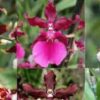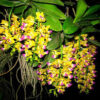# Tips for Protecting Oncidium Orchids from Harsh Weather Conditions

Oncidium orchids, commonly known as “Dancing Lady Orchids,” are adored for their unique and vibrant flowers. However, these beautiful plants can be vulnerable to extreme weather conditions, including intense heat, heavy rain, and cold temperatures. Protecting Oncidium orchids from harsh weather is essential to maintaining their health and ensuring they thrive in your garden or home. In this comprehensive guide, we will explore various strategies to safeguard these delicate blooms, providing you with practical tips and techniques for different weather scenarios.
## Table of Contents
1. **Understanding Oncidium Orchids**
– 1.1 Characteristics of Oncidium Orchids
– 1.2 Ideal Growing Conditions
2. **The Impact of Harsh Weather on Oncidium Orchids**
– 2.1 Effects of Heat and Sun Exposure
– 2.2 Risks of Heavy Rain and Humidity
– 2.3 Challenges of Cold Temperatures
3. **Tips for Protecting Oncidium Orchids in Extreme Heat**
– 3.1 Location and Placement
– 3.2 Watering Strategies
– 3.3 Using Shade Cloths and Covers
4. **Strategies for Safeguarding Orchids During Heavy Rain**
– 4.1 Proper Drainage Solutions
– 4.2 Choosing the Right Containers
– 4.3 Monitoring Humidity Levels
5. **How to Protect Oncidium Orchids from Cold Weather**
– 5.1 Indoor Relocation
– 5.2 Using Greenhouses and Tunnels
– 5.3 Insulating Techniques
6. **General Care Tips for Weather Resilience**
– 6.1 Fertilization and Soil Health
– 6.2 Pest and Disease Management
– 6.3 Seasonal Maintenance
7. **Conclusion**
## 1. Understanding Oncidium Orchids
### 1.1 Characteristics of Oncidium Orchids
Oncidium orchids are recognized for their unique flower shape and vibrant colors, which can range from yellow to brown, with some varieties exhibiting speckles or patterns. These orchids are epiphytic, meaning they naturally grow on other plants, drawing moisture and nutrients from the air and surrounding environment. This growth habit influences their care and protection strategies.
### 1.2 Ideal Growing Conditions
Oncidium orchids thrive in warm, humid environments, with temperatures ideally ranging from 60°F to 80°F (15°C to 27°C). They require bright, indirect sunlight and should be watered regularly, allowing the potting medium to dry slightly between waterings. Understanding these ideal conditions is crucial for safeguarding them against harsh weather.
## 2. The Impact of Harsh Weather on Oncidium Orchids
### 2.1 Effects of Heat and Sun Exposure
Excessive heat can lead to wilting, sunburn, and stress in Oncidium orchids. Prolonged exposure to direct sunlight can scorch the leaves and flowers, ultimately affecting the plant’s health and blooming potential.
### 2.2 Risks of Heavy Rain and Humidity
While Oncidium orchids enjoy humidity, excessive rain can lead to waterlogged roots, promoting rot and fungal diseases. High humidity levels, combined with stagnant air, can also encourage pests and mold growth.
### 2.3 Challenges of Cold Temperatures
Cold weather can severely damage Oncidium orchids, particularly if temperatures drop below 50°F (10°C). Frost can kill young plants, while prolonged exposure to low temperatures can hinder growth and flowering.
## 3. Tips for Protecting Oncidium Orchids in Extreme Heat
### 3.1 Location and Placement
One of the most effective ways to protect your Oncidium orchids from heat is by choosing the right location:
– **Shady Spots**: Position your orchids in areas that receive bright, indirect sunlight rather than direct sunlight, particularly during the hottest parts of the day.
– **Outdoor Protection**: If growing outdoors, place the orchids under trees or larger plants that can provide natural shade.
### 3.2 Watering Strategies
During periods of extreme heat, it’s essential to adjust your watering practices:
– **Frequent Watering**: Increase the frequency of watering to prevent the roots from drying out. Check the moisture level of the potting medium regularly.
– **Early Morning Watering**: Water in the early morning to allow the plant to absorb moisture before the heat of the day sets in.
### 3.3 Using Shade Cloths and Covers
If you are unable to provide natural shade, consider using shade cloths or temporary covers:
– **Shade Cloths**: These can be draped over the plants during the hottest parts of the day, providing protection from intense sunlight.
– **Portable Covers**: Use lightweight, portable covers that can easily be set up and taken down as needed.
## 4. Strategies for Safeguarding Orchids During Heavy Rain
### 4.1 Proper Drainage Solutions
Effective drainage is crucial for preventing root rot during heavy rain:
– **Elevated Pots**: Use pots with good drainage holes and elevate them slightly to ensure excess water can escape.
– **Draining Areas**: Consider placing your Oncidium orchids in areas where water tends to drain quickly, avoiding low spots that can become waterlogged.
### 4.2 Choosing the Right Containers
Select appropriate containers that facilitate proper drainage:
– **Clay Pots**: Clay pots are porous and can help prevent water buildup, allowing the roots to breathe.
– **Self-Watering Pots**: These can help regulate moisture levels, but ensure they are designed to prevent water from sitting stagnant.
### 4.3 Monitoring Humidity Levels
Monitor humidity levels carefully to ensure they remain optimal:
– **Humidity Gauges**: Use hygrometers to check humidity levels regularly. Ideal humidity for Oncidium orchids is between 50% and 70%.
– **Air Circulation**: Provide adequate airflow to prevent stagnant conditions that can lead to mold and disease.
## 5. How to Protect Oncidium Orchids from Cold Weather
### 5.1 Indoor Relocation
As temperatures drop, consider moving your Oncidium orchids indoors:
– **Temperature Control**: Bring your orchids inside if outdoor temperatures are forecasted to drop below 50°F (10°C).
– **Avoid Drafts**: Place them in a location away from cold drafts, such as near windows or doors.
### 5.2 Using Greenhouses and Tunnels
For those with larger collections, greenhouses or temporary tunnels can be effective:
– **Greenhouses**: Invest in a greenhouse to maintain a controlled environment for your orchids throughout the year.
– **Cold Frames**: Use cold frames to protect plants from frost while still allowing sunlight in.
### 5.3 Insulating Techniques
If keeping orchids outdoors during cold weather is necessary, employ insulation techniques:
– **Bubble Wrap**: Wrap pots in bubble wrap to provide insulation from the cold.
– **Mulching**: Add a layer of mulch around the base of the plants to help retain warmth in the soil.
## 6. General Care Tips for Weather Resilience
### 6.1 Fertilization and Soil Health
Healthy plants are better equipped to withstand harsh conditions:
– **Balanced Fertilizers**: Use balanced fertilizers to promote healthy growth and resilience.
– **Well-Draining Soil**: Ensure your potting mix is well-draining and contains organic matter for added nutrients.
### 6.2 Pest and Disease Management
Regularly check for pests and diseases, which can be exacerbated by stressful weather conditions:
– **Inspect Plants**: Check the undersides of leaves for signs of pests like aphids or mealybugs.
– **Preventative Measures**: Use insecticidal soap or neem oil as a preventative measure against pests.
### 6.3 Seasonal Maintenance
Adapt your care routine to the changing seasons:
– **Spring Preparation**: Inspect your orchids for any damage after winter and prune any dead or damaged parts.
– **Fall Readiness**: Prepare your orchids for winter by gradually reducing watering and fertilization as temperatures drop.
## 7. Conclusion
Protecting your Oncidium orchids from harsh weather conditions is essential to their health and beauty. By understanding the impacts of extreme heat, heavy rain, and cold temperatures, and implementing effective strategies for protection, you can ensure these stunning plants thrive in your care. With the right location, watering practices, drainage solutions, and seasonal maintenance, your Oncidium orchids can withstand the elements and continue to provide you with beautiful blooms year after year. Embrace these tips and enjoy the elegance of your orchids while ensuring they are safeguarded against the challenges of nature.

